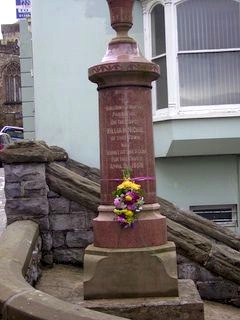William Nichol Memorial

William Nichol memorial
On the 9th April 1558 William Nichol was burned alive near the top of High Street. He was one of many unfortunates who have become known as the Marian Martyrs, three of whom were to suffer such a fate in Wales.
The name Marian comes from Mary, Catholic Queen of the time who not surprisingly has become known in history as Bloody Mary as a result of her policies in respect of the treatment of Protestants such as William Nichol.
During the five short years of Mary’s reign, 1553-1558, three hundred people were burnt at the stake. For the most part, they are described as plain men and women - there were sixty women - who died for their religion. There were others who died by ‘torment’ and the total of martyrs rises dramatically when taking account of them...on average, one every five days during Mary’s reign.
The burnings took place mainly in London and the south-eastern midlands and the fact that William Nichol was burnt in Haverfordwest points to the importance of the town during this period.
The other two Welsh martyrs were Rawlings White, a poor fisherman, burned in Cardiff on the 5th March 1555, and a former bishop of St Davids, Bishop Robert Ferrer, burned in Carmarthen on the 30th March 1555.
‘The Spanyards have made us Inglishmen wondrous vile’, was a comment quietly murmured at the time, placing blame with Mary’s husband Phillip of Spain.
Foxe’s Book of Martyrs published in 1563, describes Nichol as, ‘so simple and good a soul that many esteemed him half foolish.’ Possibly because of this there are many local historians who have chosen to refer to Nichol as a lunatic who barely knew what was happening to him. However, practically nothing is known about him, and Foxe in his Book of Martyrs goes on to admit that whilst he did not truly know much about Nichol, “he dyed a good man and in a good cause whatsoever they judge of him.”
There is a sad irony in the fact that just six months after Nichol’s death, in November 1558, Elizabeth I was crowned Queen of England and returned the country to Protestantism. She showed a tolerant attitude towards religious matters for the first eleven years of her reign but as plots to depose her in favour of Mary Queen of Scots (a Catholic) multiplied so her position hardened. There were no burnings but many executions for treason which attracted another horrific form of death, that of being hanged, drawn and quartered. But even here, Elizabeth found this so revolting that she decreed after 1586 that those so condemned were to be hanged until dead before being drawn and quartered.
A large stone, (about four feet high) known as “The Martyr Stone”, stood on this spot for centuries and was taken to Dale Castle, sometime during the late nineteenth century for safe keeping , where it still remains.
In the 1930s Post Office workers found a hole six inches square and three feet deep, about forty five feet down from where the memorial now stands. The present pillar of polished red Balmoral granite was erected in 1912, as a result of a joint decision and pooling of resources of local churches and was unveiled by the Mayor of the town, Councillor George Davies. During the ceremony, George Davies had this to say, ‘To the martyr William Nichol and to others like him, noble men of the past, we owe much, and although this memorial is long overdue, yet it is not too late to show our gratitude for the freedom which is ours.’
For many years, the historian who composed this Heritage Trail has attached a small bouquet of flowers to the memorial on the 9th April in an attempt to remember the man who suffered such horror and to perhaps remind the town of an aspect of its history.
The inscription on the memorial states;
The noble army
of Martyrs praise thee.
On this spot
William Nichol
of this town
was
burnt at the stake
for the truth
April 9th 1558.
Base map from openstreetmap.org